

This year has seen fantastic weather for blossom time and petal fall is rapid as fruit set is enjoying perfect temperatures.
It is a long time since we have seen a season like this, usually if lucky we get patches of warm sunny weather leading up to blossom time and a day or two warm enough to get the pollinating insects doing their job!
Of course good weather for pollination is the first thing on our minds, but Fertilizationis a critical element in the process of achieving a good crop.
On the subject of pollination, the weather is key. Ideally a constant day time temperature of 20 C with no frost at night is utopia, however that rarely happens. Many factors influence fruit set, the quality of fruit bud; namely its nutrient reserves, depend on circumstances over the past 9 months; the influence of last seasons crop load, the speed with which the crop was removed last autumn (the later the harvest, the more stress on the tree) winter chill, e.g. sufficient dormancy (trees need to sleep) all affect the fruit bud quality.
2025
Now this year the strength of the fruit bud augers well for a good crop. We had near perfect conditions for achieving Winter chill essential for creating strong fruit buds which in turn makes a good 'fruit set' probable.
With plenty of blossom; it needs no more than 5-15% of those flowers to 'set' and become apples to produce a full crop.
The pictures below in my garden, indicate the speed with which pollination and fertilization is taking place.
Below: left. Full bloom on Sunday and right. 'And today' after petals started falling rapidly on Tuesday
Below: Pollen sacs intact (cream) and pollen sacs open (brown) while 'humble bumble' keeps busy
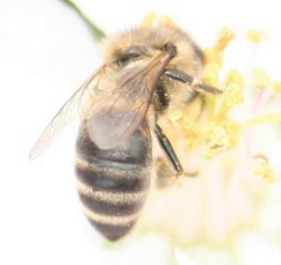 A honey bee at work To achieve pollination and fertilization pollen must be passed from the pollen sacks to the style and grow down the pollen tube as quickly as possible.
A honey bee at work To achieve pollination and fertilization pollen must be passed from the pollen sacks to the style and grow down the pollen tube as quickly as possible.
In warm weather this can happen in a matter of hours; in cold conditions it can take days. If the pollen does not reach the ovary in time (approx 4 days) it is too late!
The process is known as the Effective Pollination Period (EPP).
Below: Illustrations: left and right. Pollination and fertilization process
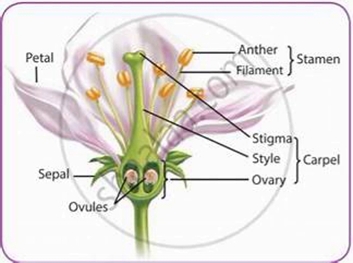
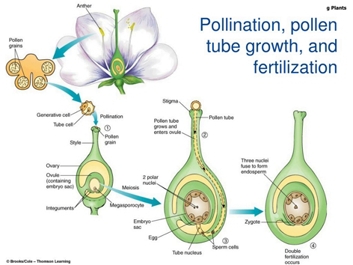
Below: 3 pictures of Apple in my garden at early fruitlet stage.
Friends and Foes
Our orchards contain many 'foes' like Apple Blossom Weevil. and 'friends' like Hoverflies and Lacewings
Below: Left-right. Apple blossom weevil larvae - Hoverfly larvae feeding on aphids - Lacewing larvae feeding on aphids
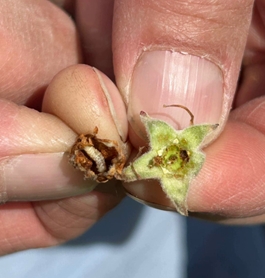
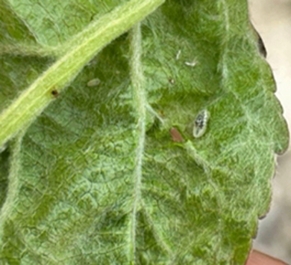
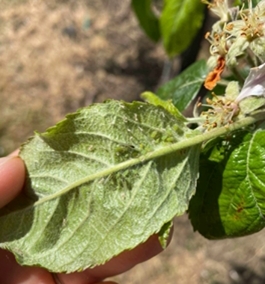
Pictures provided by BAPL Orchard Watch members
------------------------------------------------------------------------------------------------------------------------------------------------------
The English Apple Man has many happy memories of visits to the Emerald Isle. 'Mrs Apple Man's Irish relatives in the Dublin area and travels around this beautiful countryside and The EAM has visited fruit growers in Armagh
Research project in Ireland
A research initiative at Teagasc's Oak Park at Carlow in Ireland aims to boost apple production by exploring innovative training systems and rootstocks.
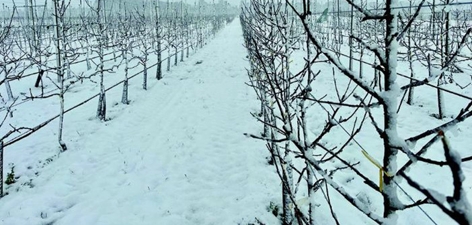 The Efficient Orchard 2024 project is focused on improving yield efficiency and enhancing fruit quality, offering Irish growers strategies tailored to the local climate. It aims to counter the fact that most of the apples in Ireland's 131m Euro market are imported, despite having a favourable climate.
The Efficient Orchard 2024 project is focused on improving yield efficiency and enhancing fruit quality, offering Irish growers strategies tailored to the local climate. It aims to counter the fact that most of the apples in Ireland's 131m Euro market are imported, despite having a favourable climate.
Teagasc Research Officer Alberto Ramos Luz said that the project marks a pivotal advance for the apple industry in Ireland. "This initiative focuses on boosting production efficiency, improving fruit quality, and cutting labour costs by testing different training systems and rootstocks", he explained. "The project's main goal is to identify the best combinations for high yield efficiency and top-quality fruit, specifically tailored to the Irish climate".
The project aims to evaluate the agronomic performance of 48 apple genotypes, including Alpigala, Story Inored, Inobi, Gala Buckeye, Elstar Red Flame, Elstar Elshof, and Wilton's Star Red Jonaprince Select. These have been grafted onto a variety of rootstocks in the research orchard, including M9, M200 and the Geneva series. The different genotypes and rootstocks will be examined in conjunction with different training systems, such as tall spindle - giving high planting density and minimal pruning, V-trellis - giving improved light exposure, and innovative two-dimensional training systems.
A key objective is to gather preliminary data on the vegetative, reproductive, and physiological behaviour of apple trees under Irish conditions, added Alberto. "The study will closely monitor phenological development, vegetative growth, such as the trunk cross-sectional area, reproductive performance, for example yield and efficiency, and fruit quality properties such as size, weight, firmness, soluble solids, acidity and colour", he said.
Although a full evaluation of the training systems would require at least 10 years to fully map, the project aims to generate essential insights that will provide a starting point for guiding future research and orchard management strategies. Understanding the behaviour of different apple genotypes under various training systems and rootstocks is essential for advancing apple production in Ireland. "The project's main goal is to identify the best combinations for high yield efficiency and top-quality fruit, specifically tailored to the Irish climate," Alberto said. "This project's research outcomes will support the implementation of new orchard practices, informing future research to maximise yield efficiency and fruit quality. Ultimately, this will make apple production more attractive to Irish farmers by enhancing profitability and offering higher quality fruit to consumers."
![]() That is all for this week
That is all for this week
Take care
The English Apple Man